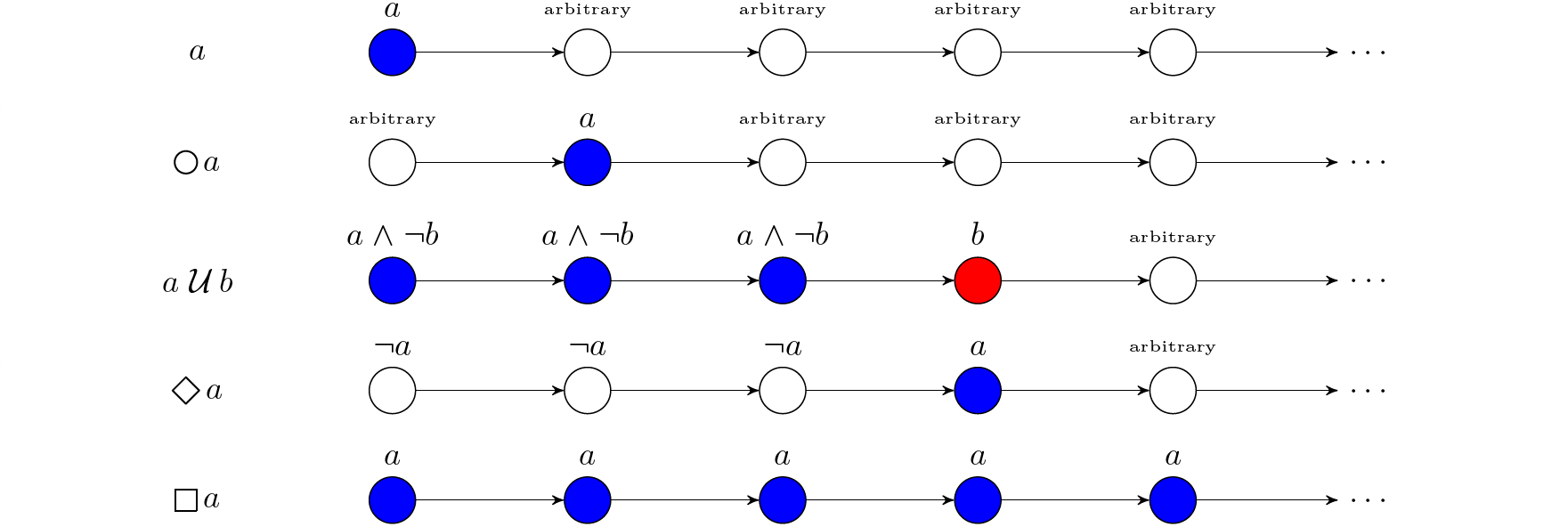Previous chapter: Deterministic vs. Nondeterministic Büchi Automata
This is a learning note of a course in CISPA, UdS. Taught by Bernd Finkbeiner
Introduction
For regular languages, Complementation is very simple: one translates a given complete deterministic automaton $\mathcal{A}$ that recognizes some language $L\subseteq\Sigma^*$ into an automaton $\mathcal{A’}$ that recognizes the complement $\Sigma^*\setminus L$ by complementing the set of final states, i.e., $F’=Q\setminus F$.
For deterministic Büchi automata, the construction is tricky, because it introduces nondeterminism
$\textbf{Construction 4.1. }\text{Let }\mathcal{A}=(\Sigma,Q,I,T,\small\text{BÜCHI} \normalsize(F))\text{ be a complete deterministic Büchi}$ $\text{automaton, where we assume w.l.o.g. that } Q\neq\varnothing. \text{ We construct a Büchi automaton}$ $\mathcal{A’}=(\Sigma,Q’,I’,T’,\small\text{BÜCHI} \normalsize (F’))\text{ with }\mathcal{L}(\mathcal{A’})=\Sigma^\omega\setminus\mathcal{L}(\mathcal{A})\text{ as follows:}$
$\begin{array}{lrll}
\hspace{1cm} \cdot &Q’&=&(Q\times\lbrace 0\rbrace)\cup((Q\setminus F)\times\lbrace 1\rbrace)\newline
\hspace{1cm} \cdot &I’&=&I\times\lbrace 0\rbrace\newline
\hspace{1cm} \cdot &T’&=&\lbrace ((q,0),\sigma,(q’,i))\mid(q,\sigma,q’)\in T,i\in\lbrace 0,1\rbrace,(q’,i)\in Q’\rbrace \cup \newline
\hspace{1cm} \ &&&\lbrace ((q,1),\sigma,(q’,1))\mid(q,\sigma,q’)\in T,q’,q’\in Q\setminus F\rbrace\newline
\hspace{1cm} \cdot &F’&=&(Q\setminus F)\times\lbrace 1\rbrace
\end{array}$
|
Explaination |
| $Q’$ |
Uses two copies of the given automaton $\mathcal{A}$, mark them seperately using $\lbrace 0\rbrace$ and $\lbrace 1\rbrace$, notice that all accpeting states from $\lbrace 1\rbrace$ are eliminated |
| $I’$ |
The complemented automaton starts from initial states from $\lbrace 0\rbrace$. |
| $T’$ |
The switch from $\lbrace 0\rbrace$ and $\lbrace 1\rbrace$ happens nondeterministically. And once you enter the second copy $\lbrace 1\rbrace$, it stays forever. |
| $F’$ |
The automaton $\mathcal{A’}$ accepts if the run ends up in the second copy, which means that, on the unique run of $\mathcal{A}$ on the input word, the accepting states of $\mathcal{A}$ are only visited finitely often. |
Note that the resulting automaton is nondeterministic. This is, in general, unavoidable.
This is because there are languages, such as $L=(b^*a)^\omega$ where the language itself is recognizable by a deterministic Buchi automaton, while its complement $\Sigma^\omega\setminus L$ can only be recognized by a nondeterministic Büchi automaton.
$\textbf{Theorem 4.3. }\textit{For every deterministic Büchi automaton }\mathcal{A}\textit{, there exists a Büchi automaton }\mathcal{A’}$ $\textit{ such that }\mathcal{L}(\mathcal{A’})=\Sigma^\omega \setminus\mathcal{L}(\mathcal{A}).$


